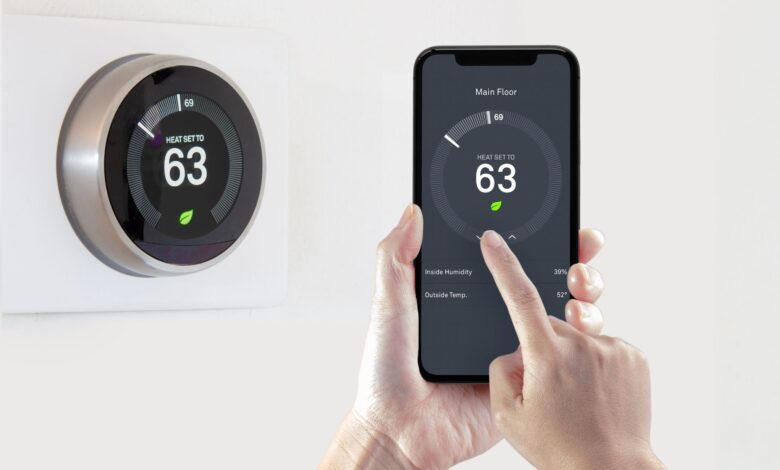Leveraging Smart Thermostats to Improve Heating Efficiency in Commercial Spaces

In a competitive business environment, companies are constantly looking for ways to reduce operational costs while maintaining a comfortable environment for their employees and customers. One of the most effective ways businesses can achieve both goals is by optimizing their energy use, particularly in heating. One such solution that’s gaining traction in commercial buildings is the integration of smart thermostats into commercial heating systems.
Smart thermostats offer businesses a wide range of benefits, from cost savings to enhanced energy efficiency. These cutting-edge devices can adjust temperatures based on occupancy and preferences and provide valuable insights into energy consumption patterns.
What Are Smart Thermostats?
Smart thermostats are advanced, Wi-Fi-enabled devices that allow businesses to control and monitor the temperature of their heating systems remotely. Unlike traditional thermostats, which rely on manual settings, smart thermostats can learn your heating preferences over time and adjust themselves automatically. These devices can be controlled via smartphone apps, voice assistants, or even through automated schedules, giving businesses flexibility and control over their heating systems.
In commercial buildings, where heating systems can often be large, complex, and costly to maintain, the benefits of integrating smart thermostats become even more pronounced. Here are several ways in which smart thermostats can optimize energy use and improve heating efficiency for businesses:
1. Real-Time Monitoring and Remote Control
One key advantage of smart thermostats according to a commercial heating company in Ronkonkoma is the ability to monitor and control heating systems remotely. Business owners and facility managers can adjust temperature settings from anywhere using a mobile app or web dashboard. This is especially useful for businesses with multiple locations or large facilities, where manually adjusting thermostats for each area can be time-consuming and inefficient.
For example, if the office or store is unoccupied after hours, a smart thermostat can automatically adjust the temperature to a more energy-efficient level, reducing unnecessary heating costs. Remote control also enables quick adjustments in response to sudden changes in weather, helping to maintain a comfortable indoor environment without wasting energy.
2. Energy Usage Insights and Analytics
Smart thermostats provide detailed reports and analytics about your energy consumption. These insights allow businesses to track their heating patterns and identify areas where energy is being wasted. For instance, if a particular area of the building is consistently overheated or underheated, this data can highlight inefficiencies in the system that need to be addressed.
By having access to real-time energy usage data, businesses can make more informed decisions about when to adjust heating, and how to optimize energy consumption across the building. In addition to reducing energy waste, this level of visibility can help businesses set realistic energy-saving goals and monitor progress over time.
3. Programmable Schedules and Automatic Adjustments
One of the most powerful features of smart thermostats is their ability to create and follow programmable schedules. Businesses can set different heating temperatures for different times of day, based on the needs of employees, customers, or building occupancy.
For example, a smart thermostat can be programmed to lower the temperature in the office during non-working hours or to increase it before employees arrive in the morning. This means that the heating system won’t be running unnecessarily when the building is empty, resulting in significant energy savings.
Some smart thermostats can even use geofencing technology to adjust the temperature based on the location of employees or the building’s occupants. For instance, when employees leave the building for the day, the thermostat will automatically lower the temperature, and when they approach the building the next morning, it will begin warming up again. This ensures that heating is optimized without human intervention.
Conclusion
Integrating smart thermostats into commercial heating systems is a smart move for businesses looking to optimize energy use, reduce operational costs, and improve heating efficiency. These devices offer a wide range of benefits, from remote control and real-time monitoring to programmable schedules and enhanced comfort for employees and customers. By leveraging the power of smart thermostats, businesses can not only reduce their energy bills but also contribute to sustainability goals and create a more efficient, comfortable work environment.
As technology continues to evolve, the role of smart thermostats in commercial heating systems will only become more critical in the quest for efficiency, cost savings, and environmental responsibility. Businesses that invest in smart heating solutions today are positioning themselves for a more sustainable and cost-effective future.
FAQs
1. How much can a smart thermostat save my business on heating costs?
The amount of savings varies depending on your building size, usage patterns, and the efficiency of your current heating system. On average, businesses can save 10-15% on heating costs by using a smart thermostat.
2. Can a smart thermostat be installed in any commercial building?
Yes, smart thermostats can typically be installed in most commercial buildings. However, it’s important to consult with an HVAC professional to ensure compatibility with your existing heating system.
3. How do smart thermostats improve energy efficiency?
Smart thermostats optimize energy use by adjusting the heating based on occupancy, time of day, and environmental conditions.
4. Are smart thermostats easy to use for business owners?
Yes, smart thermostats are designed to be user-friendly. They can be controlled remotely via a smartphone app or web dashboard, making it easy for business owners to monitor and adjust their heating systems from anywhere.



